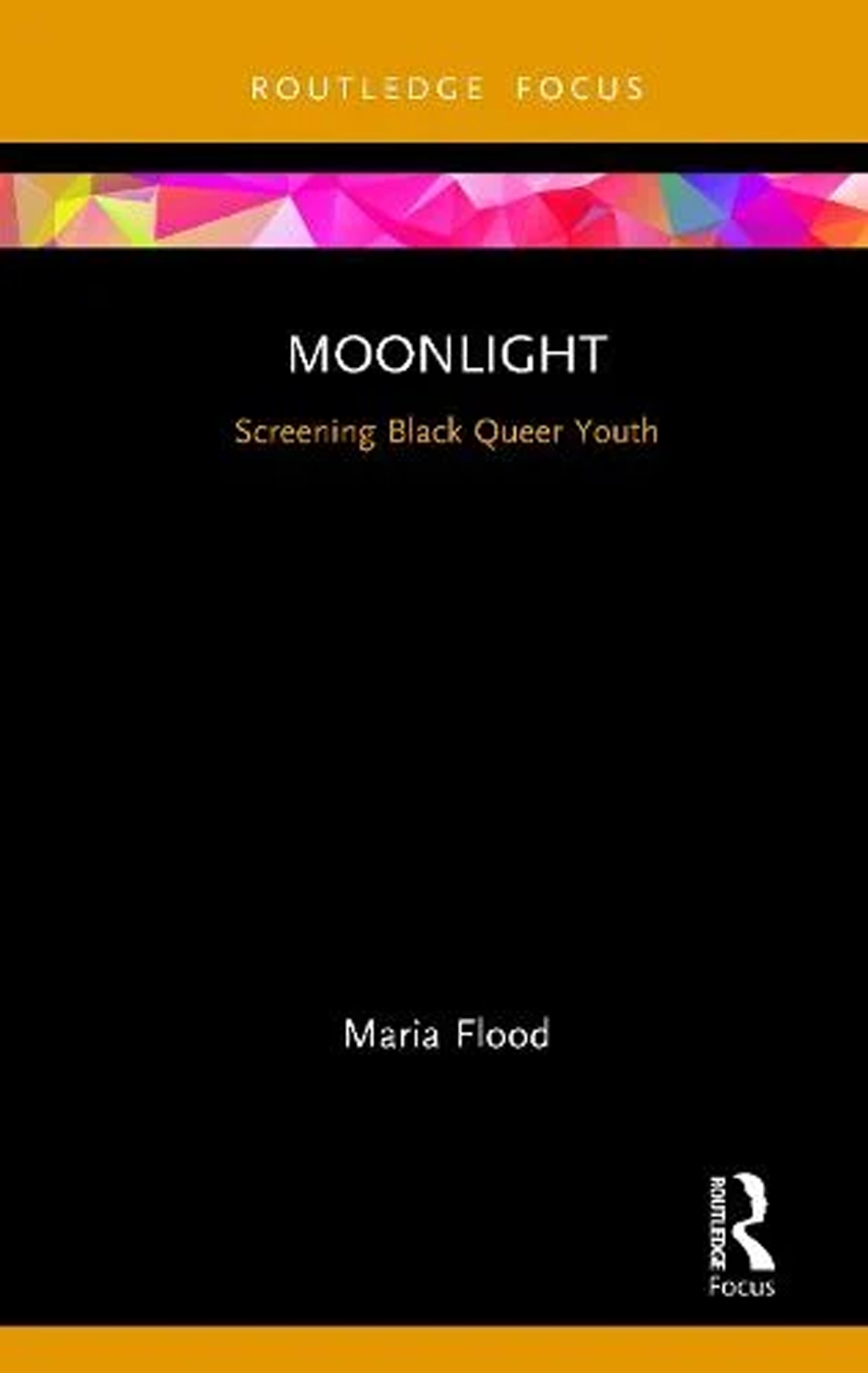At the close of the 2010s, a critical consensus emerged around celebrating Moonlight (Barry Jenkins, 2016) as one of the defining films of the decade. A large body of scholarly work on the film was likely to follow, and so Routledge has published, within its Cinema and Youth Cultures series, the first book-length essay on it: Moonlight: Screening Black Queer Youth, by Maria Flood.
Flood introduces the book by grounding the film in three contexts: the political shifts in the USA at the time of its release (Chapter 1), a genealogy of Black masculinity on screen (Chapter 2) and the development of Moonlight as a queer film (Chapter 3). She locates Moonlight in the juncture between the Obama and Trump administrations, when hope for a ‘post-racial’ USA in the wake of the country’s first ever Black president met with a warning about whose voices would be marginalised during Trump’s time in office. This political frame is completed by the problematisation of Moonlight’s position in relation to its awards success in the context of the #OscarsSoWhite campaign and ‘the tendency of Hollywood and the media toward tokenism’ (17).
While acknowledging this issue, Flood delivers a compelling case for ‘the film’s progressive social and political aims’ (17) and its construction of meaning. Moonlight is discussed in chapter 2 as both following and departing from other waves of Black filmmaking in the USA, mainly the Blacksploitation films of the 1970s and the New Black Realism of the 1990s, especially regarding the notion of stereotyping. Moonlight contains a number of those stereotypes perpetuated in these previous waves, including its depiction of drug use and drug trafficking, but at the same time ‘undermines and renders them complex through nuanced characterization’ (23). The author explores her claim in certain elements of the text, such as the importance of food, which introduces nurturing and care into the masculinities of Juan and Kevin in relation to Chiron, and the prevailing presence of physical boundaries in the space of Liberty City, especially in the school, that constrict the growth of Chiron’s masculinity. The discussion also acknowledges problems with the representation of race in the film. Flood includes critiques in relation to the film’s lack of engagement with the structural origins of poverty and racism, especially when it comes to ‘self-actualisation’ (34) and the possibility of Chiron redefining his identity in such a constrictive space. However, she contends that ‘the film tentatively places the possibility of redemption in the people of Liberty City’ (34) and, therefore, restores agency to its characters.
After focusing on Black filmmaking, Flood threads a discussion about the intersection between race and queer sexuality in the film in chapter 3. The author works through the representation of some of issues that the film poses, including Chiron’s embodiment of heteronormative masculinity in its third part, the use of stereotypes of queer Black men, the normalisation of bullying narratives involving queer characters and the absence of onscreen sex. Flood engages with these issues by identifying the importance of Chiron’s gaze, its ‘watchfulness’ (48), which is present in the performances of the three actors who play him but also in the shots that reveal the space of the film in 360 degrees. This watchfulness is related both to the threats that Chiron faces due to his sexuality and to his engagement with the world that surrounds him, in a mixture of masculine and feminine characteristics. As a result of these observations, Flood proposes we follow E. Patrick Johnson and call Moonlight ‘quare’ rather than ‘queer’, a term that she playfully links to her childhood memories of Ireland. According to her, the use of the term quare ‘opens a space in which gender and sexuality can be explored alongside race and class’ (54). This, in her view, is the key to circumventing problems in the representation of race and sexuality by making the two categories, plus that of class, intersect in a dialogue.
These first three chapters’ systematic approach to the different theories and fields that intersect in Moonlight enable the author to focus on the film’s construction of meaning in the remaining two chapters. Specifically, chapter 4 discusses the narrative, setting, and symbolism of the film, while chapter 5 develops how these elements result in an expression of empathy and Black boyhood. For instance, Flood conveys an illuminating point about how the time of the film is that of Chiron’s subjectivity and, significantly, that of his emotional engagement with the rest of the characters. This time is marked by the repetition of certain visual elements, such as water. However, the author produces the book’s strongest sections when she discusses how patterns of colour articulate meaning and affect. In the first part of the film, green and blue predominate, associated with positive aspects of Chiron’s early life, especially his first encounters with Juan and Kevin. The second part is coded by yellow, present for instance in Chiron’s shirts, and Flood identifies sickness and danger in it, both in Chiron’s relation to violence and in the worsening of Paula’s addiction. Finally, the third part entails a melange of dark tones for Black, of blues and greens in the final scene between Chiron and Paula, and red for the meeting with Kevin. The importance of identifying the colour coding lies in its close relation to the subjectivity of Chiron and the empathic consequences on affect in the viewers.
This emphasis on empathy introduces a final debate with which the book engages. Flood poses the question of whether Moonlight’s general appeal to a wider audience benefits or harms the portrayal of Black queer youth as embodied in Chiron. To tap into this, she focuses on the film’s depiction of childhood, acknowledging that the specificity of Black childhood leads to ‘a representation twice removed: by adults and through the lens of whiteness’ (84). In her view, there is a danger that the film’s universal appeal might restrict the representation of childhood because it is oriented to be consumed by adults. Likewise, the specificity of Chiron’s Black childhood can be threatened once it enters the White-dominated mainstream. Once again, Flood attempts to circumvent this danger in her own discussion through close textual analysis, specifically of ‘space, being and the [film’s] three-part structure’ (86). In terms of space, the author analyses the famous swimming scene to make a convincing argument for the representation of nature as a real space of freedom, fear and pleasure, which encapsulates the amalgam of feelings experienced by the child who is discovering the world. Moreover, Flood explains that the film’s choices in cinematography serve to represent the gaze of the child, in which there is an ‘overlapping of sight and emotion’ (88). A final argument is made in favour of the choice of clearly separating the three periods of Chiron’s life, marking them by casting three different actors, which Flood calls a ‘balancing act’ (p.90). This is because the film ‘captures the feeling that one can be three quite different people at these stages of life, that the experiences one has can change one profoundly, and yet some threads of character will be pulled across the years (90). This observation applies especially to Chiron, whose mistakes are punished so harshly. Flood concludes with a renewed defence of Moonlight which, while acknowledging potential issues of representation, considers Jenkins’ work to have made Chiron’s childhood ‘not only visible, but comprehensible’ (94).
Flood closes her book by realising that the formula ‘both/and’ has become a structuring leitmotif of her writing, because it represents the way in which Moonlight refuses to be placed into neat artistic categories. Moonlight: Screening Black Queer Youth stands as a mediator — a map with which to navigate the thematic complexity of Jenkins’ film, the crossroads at which the film is situated, between Black filmmaking, queer cinema and the depiction of youth, and the exuberance of its aesthetic choices. The systematic approach to the film, combined with the sharp focus on close textual analysis, make the book an essential guide that will only enhance the viewership of Moonlight.
Competing Interests
The author has no competing interests to declare.

